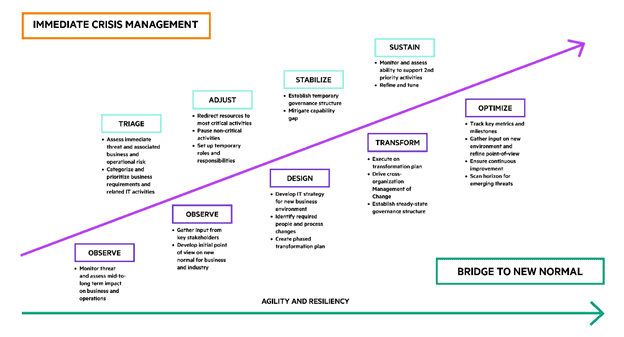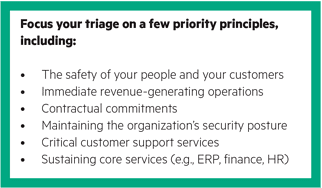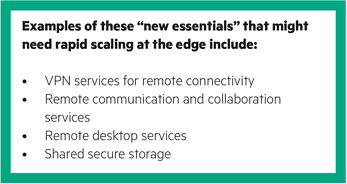Posted with permission from Enterprise.nxt from Hewlett Packard Enterprise written by Rohit Dixit
An IT response to the coronavirus crisis demands both an immediate and longer-term crisis management plan that readies the company to succeed in a changed world. We present a nine-step guide.
For many weeks, the world has been reacting to a global pandemic that has affected every aspect of the way we live and work. As a global technology company that operates thousands of customer environments and provides advisory expertise, we have learned some important lessons about how to manage this particular crisis. In partnership with our customers, we have also begun to think about the world beyond this global event―with the hope that economies will restart and life will return to a future normality. This new normal has the potential to fundamentally change what we do and how we do it. For the bold, there are new opportunities to lead their industries and shape the future.
We have developed a clear nine-step plan, composed of two phases, for organizations to follow to navigate the immediate crisis and, almost in parallel, plan for the medium to long term. The first four steps are related to immediate crisis management, activating the organization’s resources to protect the business fundamentals and operate with enough capacity to fulfill only the highest-priority needs. The latter five steps establish the bridge to the new normal. They need to commence in parallel to the first four―but not until some fundamentals of crisis management have been established.
The overlap in the model is deliberate and reflects the need to have some resources applied to internal pressures while others are focused on the broader landscape and your organization’s future. This is not indicative of a single team with an expanded role but rather implies that different sets of resources will be needed to manage and explore different trajectories in a coordinated way.

First phase: Crisis management
First, let’s focus on the immediate crisis management. These first four steps need to be set in the context of balancing two dimensions simultaneously: first, identifying and maintaining a minimum viable operating model, and second, determining where to slow (or even stop) the execution of projects to focus on changes already rippling throughout the organization.
Step 1: Triage
Define the critical baseline that enables minimum viable operations, and get immediate visibility into any changes that are planned in those environments. When gathering this data, isolate anything that is core to service availability and uptime, and question changes that relate to features and function. Pivot hard toward uptime and minimal support coverage, which means making hard decisions to cancel many items in the change backlog.

Even if the result of this triage is a decision not to go ahead with many planned changes, ensure you retain a picture of the original plan. Understanding where you were before the crisis is going to be a valuable reference point in the future. Resources are going to be at best unpredictable and at worst unavailable. Make sure any resources (people, capital, time, etc.) are directed toward activities related to the highest priority of the triage step.
For your workforce, focus on systems that keep the organization connected, communicating, and productive. As workers retreat back to their homes, categorize and prioritize systems that enable this sudden distribution of labor. You may need to consider fast-tracking planned (or unplanned) changes that can increase capacity for remote working scenarios.
The key here is to assess and categorize your current position, clearly defining essential systems and their minimum viable operating model, nonessential changes that will be revoked, and new essential scale-out actions that need to be taken (e.g., increase licensing models).

Step 2: Adjust
This mix of focusing efforts on core principles, shutting down nonessential changes, and spinning up new essentials will also invoke an emergency set of roles and responsibilities. This temporary governance structure and related processes will determine how to coordinate and communicate (internally and externally) your adjusted position to everyone affected, clearly explaining how you are acting on it. This is likely connected to a broader companywide adjustment in the organization’s operating model, covering supply chain management, manufacturing, order management, and other critical activities.
Having triaged the work to be done, assemble small teams that can act swiftly on those priority actions. Empower them to act, supported by light-touch interim governance model, with rapid cadences that can support the teams in making quick decisions. At this point, the focus is on directing traffic quickly rather than creating a cumbersome control point that could be overwhelmed. Speed is key at this point, acknowledging that some decisions will be the wrong ones.
Understand that resources directed to the various teams established in this step are likely to become consumed by these activities. It won’t be clear how long the organization will need to operate in this temporary mode, so plan for those resources to focus on these iterative adjustments for some time. Keep the teams together, as they will maintain the insights into why critical decision were made.
Start to pivot to the second phase
As CIOs lay down the fundamentals of the triage and adjust steps, now is the time to assemble a different set of resources with the strategic task of planning for the future. This team will have broad input and include stakeholders from multiple vantage points in the organization. How is technology helping to reshape the industry? Are there already early signs of new opportunities and fundamental market shifts that will sustain the organization into the future?
If there is a proven sustained ability to support a minimum viable operating model, the time is right to step across the chasm of the model and begin to look for opportunities to redefine the future. It is this subtle shift in thinking and planning that transitions the organization into the bridge to new normal phase of the nine-step model.
Step 3: Stabilize
You are now getting a feed of information and insights about how the triage and adjust steps are functioning, and you can begin to see the results of decisions made. This flow of data now needs to be converted from purely short-term immediacy to include data points that apply to the medium term. Formulate a wider functioning governance model that can take the adjusted baseline and run with it. Working within the teams, ensure this new governance model continues to broadly communicate what the evolving strategy is.
The potentially radical shifting of the IT position over the previous steps will need to start to become transparent to the organization. Rather than being interpreted as reactionary, the adjusted rigor and discipline with which the IT function is now operating will be increasingly understood across the organization as a whole. Stakeholders and beneficiaries of large digital transformation efforts will scale back expectations in line with the evolving situation.
Having captured and addressed the threats on a priority basis, and having adjusted your position, you now need to more clearly define the gap between maintaining a minimum viable operating model and providing the resources that will be required to meet it. When capability and capacity gaps are identified in the interim operating model, consider fast-tracking conversations with your broadest ecosystem/external partners to help close them. In moments like this, the power of your partnerships (strategic, technology, supply chain, etc.) will play a significant role in getting you through crisis management.
Step 4: Sustain
This step is a proof point to the internal organization, as well as to the external market, that the work in the previous steps is paying off. Newly scaled-out front-end services will need time for their performance to be measured and stabilized. A data-driven picture of the remote-working demands on services will emerge over a relatively short period of time. As bottlenecks and pain points are identified, swift adjustments can allow for improved consistency of service experience. This may involve iterations of scaling efforts and fine-tuning services to meet fluctuating demand. The same notion of iterative adjustments based on more data will be equally applicable in back-end services. Now, you can begin to correct some of the decisions that were wrong in hindsight.
Interestingly, as it operates in this emergency mode, the organization may also realize that some of its past assumptions or sacred cows can be questioned. Ensure that you capture these learnings, as they will be invaluable as you build a bridge to the new normal
Second phase: Bridge to the new normal
Somewhere between the adjust and stabilize steps of immediate crisis management we began to spin up a different team―running in parallel. It is not focused on the immediacy of the disruption but instead looking out toward a new future and shaping the trajectory of the organization. Let’s look at the steps that are driving these activities.
Step 5: Observe
This global pandemic event is forcing governments to take unprecedented actions and make policy changes that affect some or all industries. Some industries are particularly hard hit: travel, tourism, recreation, pubs, restaurants, cinemas, and more. Each of these has a broad ecosystems and upstream supply chains that equally feel the effects. And despite this, critical national services and infrastructure need to continue to deliver for their citizens. The way we live and work may not just be temporarily changed. There may be new business opportunities and ways of working that sustain a new economic model in the future.
In these early stages of coping with this scale of disruption, bring on stream a group that can begin to make sense of the emerging reality. As the CIO, direct the team to start identifying how emerging solutions and trends are enabled through technology. Be deliberate in crafting the narratives of where technology is playing a major role moving forward―for example, converting customer interactions to online/digital.
Don’t limit the observations to what can already be seen, but rather project forward into multiple scenarios that have potential to flourish. Have new market opportunities opened up that you can take advantage of? Has your industry been significantly altered? Scenarios that were previously not considered mainstream or core to your value proposition might now take on new significance.
Consider ideas over multiple time horizons―nothing is right or wrong at this point. The observations are to enable broad discussions and may find resonance where previously such ideas would have been discounted. Ask yourself if your competition is already outperforming you, and if so, why?
Never waste a crisis: It may be necessary to restart your industry with a different trajectory, one that is digitally enabled, built for agility, and designed with resilience from future disruptions. The bold will find opportunity in disruption.
At the same time, this step should also cover activities that honestly and openly observe previous weaknesses internally. Were your systems able to scale overnight to a differently shaped demand? Which systems coped well, and which were vulnerable to the changing landscape? Were there new architectural and financial models that outperformed others, and if so, why? Did your partners step up to support you in innovative ways?

MiCloud Flex Brochure
With MiCloud Flex, you can bring unified, mission-critical communications into the cloud for increased efficiency, simplicity, and mobility. Designed for large enterprises and organizations that require a rich unified communications (UC) environment, MiCloud Flex delivers the highest levels of performance, reliability, and security.
Step 6: Align
Having observed the external macro trends and internal vulnerabilities, spend a period of time on collective reflection on the observations you captured in the previous steps. Take a position on your observations. Then, include multiple internal functions in this alignment and lead them through a discussion on potential options, shaping up the story of your own survival, with a balanced view of what is working and what needs to be changed.
From previously unconsidered use cases a new best practice for the organization might emerge. Identify consensus around which innovations could persist to fundamentally change your operating model―and in some cases, even challenge your business model. Continue to reach out to the crisis management team, as it will have data on the ever-changing landscape, which may shift or change perceptions here.
Directional consensus―not detailed planning―is the goal right now. Play out scenarios and make judgement calls where data is missing based on your observations and market instincts. Where you can, match anecdotes to actual data. From an internal perspective, include performance, availability, and uptime metrics from the back end―as well as productivity from the front end. Look to incorporate new methodologies from the partners that are involved in the crisis management phase. Frame the consensus from the teams through the lens of short-, medium-, and long-term agreements.
Ultimately, drive the alignment around technology-enabled use cases. Increasingly, this will be the key to organizations differentiating themselves in their industries―and they will look to the CIO to lead.
Step 7: Design
At this point, you can revert back to the fundamentals of developing technology-enabled investment strategies. Working with your own enterprise architecture team, as well as internal stakeholders and external partners, begin to build out a model for the new normal. Design in the lessons learned through the crisis management phase to create the resilience to mitigate unknown future (albeit potentially similar) circumstances. Design in the opportunities you’ve captured within the observation step to capitalize.
Put some flesh on the bones of the consensus reached during the align step. Design scenarios that follow the short-, medium-, and long-term options. Look back at the halted change backlog described in triage. Were there planned digital capabilities that may now underpin the go-forward scenarios, providing the opportunity to accelerate outcomes? Some items in the design may be low-hanging fruit that is easy to capitalize on. Options may simply be the restructuring of existing commercial agreements, in some cases, the introduction of new tools and services that augment or replace existing services.
Show how the scenarios could be delivered, distinguishing between those targeted at the operating model of the organization to drive productivity versus the more disruptive ambitions that reach into the heart of the organization’s underlying value proposition. Challenge the design to include these disruptive initiatives, using the disruption as a chance to think differently. Remember to be bold―there are no sacred cows anymore.
Can I build into the design the combination of a future transformation vision with a leapfrog to next-generation architectures and service offerings? Can I build in increased levels of automation and orchestration, combined with cloud architecture scale and resiliency? In an increasingly digitally driven era, technology-enabled outcomes will be extended from edge to cloud and be driven by data. In which case, how will these be factored into the design?
Ensure you identify and understand the risks, prerequisites, and dependencies of the design. Map these together onto a common visual framework to de-risk the path to value realization. Make sure initiatives at the edge connect through to initiatives in the digital supply chain. Examine correlations around common enablers such as data, intelligence, security, people, and process. Resolve open questions and considerations about how an as-a-service model would be injected into the outcome. Perhaps buy-back or as-a-service models will provide the bridge to a financing model that unlocks your ability to deliver the upcoming transformation.
Once the big picture design is in place, piece together what will be needed to support and operate in this mode. Describe the operating model, the key activities you will own and deliver, and where you will partner.

TOLLY ENTERPRISES FAVORS MITEL MICLOUD FLEX OVER SOLUTIONS FROM 8X8 AND RINGCENTRAL
Step 8: Transform
With a future design described at the high level, it’s time to get the teams in your ecosystem to work on how to make it happen. This includes the key transformation partners that you want to work with to help you bridge to the creation of an executable wave of activities, using the common model you prepared in the design step to keep all teams coordinated.
Look for innovative ways to finance the transformation so as to keep precious capital flowing through the balance sheet―remember cash will still be king for some time. In selecting technology partners, ensure that they can provide the capabilities to deliver this new normal, and share your appetite to be bold and create market differentiation.
Identify your future-state “right mix” of platforms and services and the migration path that needs to be put into effect during the transform step, which includes identifying priority workloads to modernize, re-factor, rearchitect, or simply replace.
The hardest part of any transformation will be evolving the operating model. At the core of any organization are the people that drive those key activities. Job roles, metrics, and governance models may all be reshaped as a part of the new normal. Managing that change to ensure the organization comes along on the journey will fundamentally dictate the outcome.
Plan to bridge or fill talent gaps through partnership as you move toward your new normal. Change in any organization, whatever the catalyst, relies heavily on people clearly understanding the objectives and their contribution and roles within it. De-emphasizing or deprecating this from any transformation plan will at best slow the progress and at worst risk any value realization intended to be delivered.
Step 9: Optimize
One of the key lessons of responding quickly to the current scenario is to keep the spirit of agility, flexibility, and innovation. There may be some areas of the plan that require a high degree of predictability and precision, leveraged from replicable outcomes delivered elsewhere. Manage them closely, ensuring milestones are achieved and KPIs are hit.
However, there may also be areas that are more exploratory. Don’t forget the newly built “muscle memory” forged in the chaos of the first phase to pursue new (often radical) ideas―and keep the innovation engine switched on. Optimization does not mean achieving a nirvana of zero escalation or zero help desk tickets. It means having the in-built agility to rapidly adapt again in the future.
Your agility should be directly correlated to the outcomes designed into the new service delivery model, the new governance structures, and the emerging landscape in your industry. Where possible, off-load operational activities to partners in your ecosystem so you can pivot resources toward innovation and value add to the organization. Defining who does what in this new construct can provide the much needed bandwidth to support ongoing optimization efforts.
As emergency mode operations are wound down, a great new asset is also created in the learning, experience, and skills your teams have developed. As you constitute your design and transformation team and the new leadership, a fresh assessment of your team, emergent leaders, and capabilities may be required.
Activate the nine-step model
The nine-step model is a prescriptive methodology to help you navigate through uncertain times. It will help you identify those core activities that sustain an organization as well as how to transition toward a future-focused new normal. Winning in this new normal will not just be about defining and managing a crisis situation. Enterprises that steer their way through it have the opportunity to find new ways to thrive in an ever-changing landscape of unknowns. Be cautious at the beginning, but emerge bold, with a clear trajectory and capability to better react in the future, more confident in your resiliency and agility to respond to whatever event could drive this kind of approach again.
